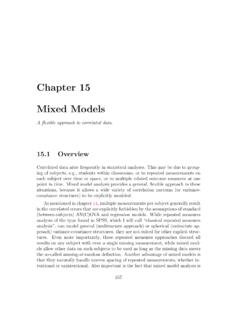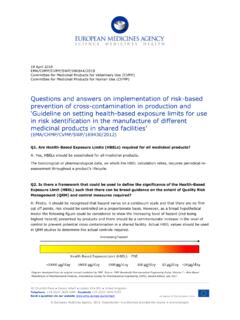Transcription of The Campus Sexual Assault (CSA) Study
1 The author(s) shown below used Federal funds provided by the Department of Justice and prepared the following final report: Document Title: The Campus Sexual Assault (CSA) Study Author(s): Christopher P. Krebs, ; Christine H. Lindquist, ; Tara D. Warner, ; Bonnie S. Fisher, ; Sandra L. Martin, Document No.: 221153 Date Received: December 2007 Award Number: 2004-WG-BX-0010 This report has not been published by the Department of Justice. To provide better customer service, NCJRS has made this Federally-funded grant final report available electronically in addition to traditional paper copies. Opinions or points of view expressed are those of the author(s) and do not necessarily reflect the official position or policies of the Department of Justice. October 2007 The Campus Sexual Assault (CSA) Study Final Report NIJ Grant No. 2004-WG-BX-0010 Performance Period: January 2005 through December 2007 Prepared for National Institute of Justice 810 Seventh Street, NW Washington, DC 20001 Prepared by Christopher P.
2 Krebs, Christine H. Lindquist, Tara D. Warner, RTI International 3040 Cornwallis Road Research Triangle Park, NC 27709 Bonnie S. Fisher, University of Cincinnati Sandra L. Martin, University of North Carolina at Chapel Hill RTI Project Number 0209487 This document is a research report submitted to the Department of Justice. This report has not been published by the Department. Opinions or points of view expressed are those of the author(s) and do not necessarily reflect the official position or policies of the Department of Justice. The Campus Sexual Assault (CSA) Study Final Report NIJ Grant No. 2004-WG-BX-0010 Performance Period: January 2005 through December 2007 Prepared for National Institute of Justice 810 Seventh Street, NW Washington, DC 20001 Prepared by Christopher P. Krebs, Christine H. Lindquist, Tara D. Warner, RTI International 3040 Cornwallis Road Research Triangle Park, NC 27709 Bonnie S.
3 Fisher, University of Cincinnati Sandra L. Martin, University of North Carolina at Chapel Hill *RTI International is a trade name of Research Triangle document is a research report submitted to the Department of Justice. This report has not been published by the Department. Opinions or points of view expressed are those of the author(s) and do not necessarily reflect the official position or policies of the Department of Justice. Table of Contents Section Page Abstract: vii EXECUTIVE SUMMARY viii 1. Introduction 1-1 A Typology of Sexual 1-3 Incapacitated Sexual 1-4 2. Background 2-1 Prevalence Estimates for Sexual Assault 2-1 The Context of Campus Sexual 2-3 Risk Factors Associated with Sexual 2-5 Prior 2-5 Substance 2-6 Age and Year of 2-7 2-7 Residential 2-7 Sorority 2-7 Dating Violence 2-8 Consensual Sexual 2-8 Attitudinal 2-8 Reporting of Sexual 2-9 Perpetration of Campus Sexual 3.
4 Research Methods 3-1 Data 3-1 3-2 Recruitment Procedures and Response 3-2 Web Site and Survey Design and 3-2 Incentive 3-5 Data 3-6 iii This document is a research report submitted to the Department of Justice. This report has not been published by the Department. Opinions or points of view expressed are those of the author(s) and do not necessarily reflect the official position or policies of the Department of Justice. Data Preparation and 3-6 Response Bias 3-7 Data Descriptive Risk Factors for Sexual 4. Study Sample 4-1 4-1 4-1 5. Findings 5-1 Sexual Assault 5-1 Prevalence 5-1 Risk Factors Associated with Sexual Assault Among University 5-6 Reporting and Sexual Assault 6. Conclusion and Recommendations 6-1 Summary of 6-1 CSA Study 6-3 CSA Study 6-6 6-7 7.
5 Future Directions 7-1 References 1 iv This document is a research report submitted to the Department of Justice. This report has not been published by the Department. Opinions or points of view expressed are those of the author(s) and do not necessarily reflect the official position or policies of the Department of Justice. List of Exhibits Exhibit Page 1-1. Basic Sexual Assault Typology .. 1-7 3-1. Diagram of Sampling Frames, Sampling Subframes, Samples, and Respondents .. 3-3 3-2. Sexual Assault Prevalence Measures ..3-12 4-1. Descriptive Data on CSA Sample of Undergraduate Women, Weighted Percentages (n = 5,446) 4-2 4-2. Descriptive Data on CSA Sample of Undergraduate Men, Weighted Percentages (n = 1,375) 4-4 5-1. Prevalence Estimates for the Sexual Assault Measures for Women, Unweighted Frequencies, Weighted Percentages .. 5-2 5-2. Percentage of Undergraduate Women Who Report Being a Victim of Forced and Incapacitated Sexual Assault Before and Since Entering 5-3 5-3.
6 Percentage of Victims of Physically Forced and Incapacitated Sexual Assault Who Experienced Sexual Battery Only and Rape .. 5-4 5-4. Prevalence Estimates for the Sexual Assault Measures for Men, Unweighted Frequencies, Weighted Percentages .. 5-6 5-5. Prevalence of Various Measures of Sexual Assault Within Demographic and Behavioral Factors for Undergraduate Women (n = 5,361) 5-8 5-6. Logistic Regression Models of Four Sexual Assault Measures (n = 4,646) 5-7. Percentage of Victims (by Sexual Assault [SA] Type) Reporting Various Victimization Contextual Factors, Unweighted Frequencies, Weighted 5-8. Reporting of Sexual Assault (SA), by Assault Type, Unweighted Frequencies, Weighted 5-9. Consequences of Sexual Assault (SA), by Assault Type, Unweighted Frequencies, Weighted v This document is a research report submitted to the Department of Justice. This report has not been published by the Department. Opinions or points of view expressed are those of the author(s) and do not necessarily reflect the official position or policies of the Department of document is a research report submitted to the Department of Justice.
7 This report has not been published by the Department. Opinions or points of view expressed are those of the author(s) and do not necessarily reflect the official position or policies of the Department of Justice. ABSTRACT: THE Campus Sexual Assault (CSA) Study Sexual Assault is a public health and public safety problem with far-reaching implications. Although a substantial body of research on Sexual Assault exists, additional data are needed to help document the current magnitude of the problem, the extent to which certain subpopulations are impacted, the consequences and reporting (or nonreporting) of victimization incidents, and strategies for preventing and reducing the risk of Sexual Assault and effectively responding to victims. One subpopulation that is often believed to be at elevated risk for Sexual Assault is college students. RTI International (RTI) was funded by the National Institute of Justice (NIJ) to conduct the Campus Sexual Assault (CSA) Study , which is a Study of various types of Sexual Assault experienced by university students.
8 This Study has one primary research objective. 1. To examine the prevalence, nature, and reporting of various types of Sexual Assault experienced by university students in an effort to inform the development of targeted intervention strategies. In addition, the CSA Study has two service-oriented objectives, the success towards which were not measured and are thus not the subject of this final report. These objectives are, however, worth mentioning. 2. To educate students about various types of Sexual Assault , how they can maximize their safety, and what they can do if they or someone they know has been victimized. 3. To provide students with information about the Campus and community resources that are available should they need assistance or have any concerns or questions. RTI has been working with two large, public universities on the CSA Study . Data were collected using a Web-based survey from over 6,800 undergraduate students (5,466 women and 1,375 men).
9 Data indicate that of undergraduate women had been victims of at least one completed Sexual Assault since entering college: were victims of physically forced Sexual Assault ; of women were sexually assaulted when they were incapacitated after voluntarily consuming drugs and/or alcohol ( , they were victims of alcohol and/or other drug- [AOD] enabled Sexual Assault ); were sexually assaulted when they were incapacitated after having been given a drug without their knowledge ( , they were certain they had been victims of drug-facilitated Sexual Assault [DFSA]). Detailed data were collected on the context, reporting, and consequences of Sexual Assault . Self-reported rates of Sexual Assault victimization and perpetration among males were very low. The primary implications of the CSA Study are the relative rarity of cases of DFSA and the need to incorporate alcohol and drug messages into Sexual Assault prevention and risk reduction programming.
10 Vii This document is a research report submitted to the Department of Justice. This report has not been published by the Department. Opinions or points of view expressed are those of the author(s) and do not necessarily reflect the official position or policies of the Department of Justice. EXECUTIVE SUMMARY Sexual Assault is a public health and public safety problem with far-reaching implications. Being a victim of Sexual Assault is one of the most violating experiences anyone can endure and can cause immediate, as well as long-term, physical and mental health consequences. Of rape victims, 25% to 45% suffer from nongenital trauma; 19% to 22% suffer from genital trauma; up to 40% get sexually transmitted diseases (STDs); and 1% to 5% become pregnant, resulting in an estimated 32,000 rape-related pregnancies in the United States annually (Holmes, Resnick, Kirkpatrick, & Best, 1996). Four out of five rape victims subsequently suffer from chronic physical or psychological conditions (Strategies for the Treatment and Prevention of Sexual Assault , 1995), and rape victims are 13 times more likely to attempt suicide than noncrime victims and six times more likely than victims of other crimes (Rape in America: A Report to the Nation, 1992).












